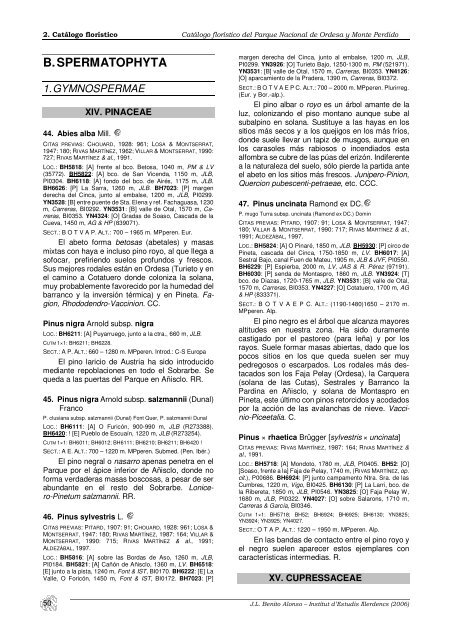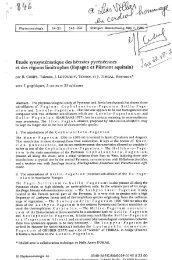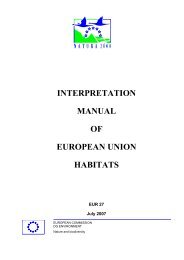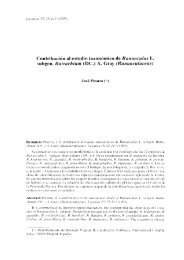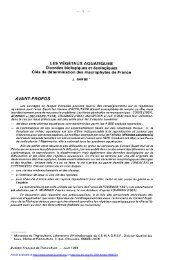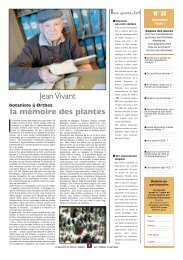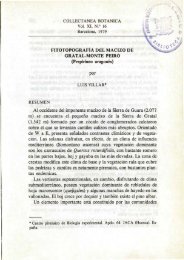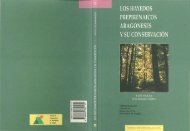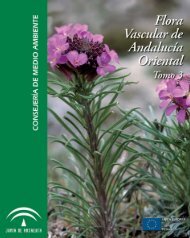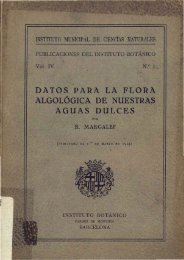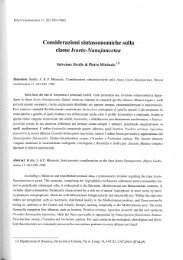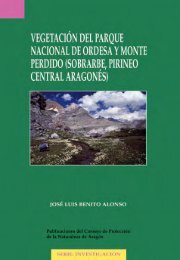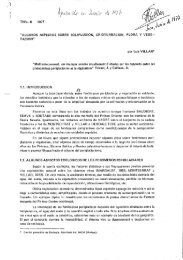Catálogo florístico del Parque Nacional de Ordesa y Monte Perdido ...
Catálogo florístico del Parque Nacional de Ordesa y Monte Perdido ...
Catálogo florístico del Parque Nacional de Ordesa y Monte Perdido ...
Create successful ePaper yourself
Turn your PDF publications into a flip-book with our unique Google optimized e-Paper software.
2. <strong>Catálogo</strong> <strong>florístico</strong> <strong>Catálogo</strong> <strong>florístico</strong> <strong><strong>de</strong>l</strong> <strong>Parque</strong> <strong>Nacional</strong> <strong>de</strong> Or<strong>de</strong>sa y <strong>Monte</strong> <strong>Perdido</strong><br />
B. SPERMATOPHYTA<br />
1. GYMNOSPERMAE<br />
44. Abies alba Mill.<br />
50<br />
XIV. PINACEAE<br />
CITAS PREVIAS: CHOUARD, 1928: 961; LOSA & MONTSERRAT,<br />
1947: 180; RIVAS MARTÍNEZ, 1962; VILLAR & MONTSERRAT, 1990:<br />
727; RIVAS MARTÍNEZ & al., 1991.<br />
LOC.: BH5818: [A] frente al bco. Betosa, 1040 m, PM & LV<br />
(35772). BH5822: [A] bco. <strong>de</strong> San Vicenda, 1150 m, JLB,<br />
PI0304. BH6118: [A] fondo <strong><strong>de</strong>l</strong> bco. <strong>de</strong> Airés, 1175 m, JLB.<br />
BH6626: [P] La Sarra, 1260 m, JLB. BH7023: [P] margen<br />
<strong>de</strong>recha <strong><strong>de</strong>l</strong> Cinca, junto al embalse, 1200 m, JLB, PI0299.<br />
YN3528: [B] entre puente <strong>de</strong> Sta. Elena y ref. Fachaguasa, 1230<br />
m, Carreras, BI0292. YN3531: [B] valle <strong>de</strong> Otal, 1570 m, Carreras,<br />
BI0353. YN4324: [O] Gradas <strong>de</strong> Soaso, Cascada <strong>de</strong> la<br />
Cueva, 1450 m, AG & HP (839071).<br />
SECT.: B O T V A P. ALT.: 700 – 1965 m. MPperen. Eur.<br />
El abeto forma betosas (abetales) y masas<br />
mixtas con haya e incluso pino royo, al que llega a<br />
sofocar, prefiriendo suelos profundos y frescos.<br />
Sus mejores rodales están en Or<strong>de</strong>sa (Turieto y en<br />
el camino a Cotatuero don<strong>de</strong> coloniza la solana,<br />
muy probablemente favorecido por la humedad <strong><strong>de</strong>l</strong><br />
barranco y la inversión térmica) y en Pineta. Fagion,<br />
Rhodo<strong>de</strong>ndro-Vaccinion. CC.<br />
Pinus nigra Arnold subsp. nigra<br />
LOC.: BH6211: [A] Puyarruego, junto a la ctra., 660 m, JLB.<br />
CUTM 1×1: BH6211; BH6228.<br />
SECT.: A P. ALT.: 660 – 1280 m. MPperen. Introd.: C-S Europa<br />
El pino laricio <strong>de</strong> Austria ha sido introducido<br />
mediante repoblaciones en todo el Sobrarbe. Se<br />
queda a las puertas <strong><strong>de</strong>l</strong> <strong>Parque</strong> en Añisclo. RR.<br />
45. Pinus nigra Arnold subsp. salzmannii (Dunal)<br />
Franco<br />
P. clusiana subsp. salzmannii (Dunal) Font Quer, P. salzmannii Dunal<br />
LOC.: BH6111: [A] O Furicón, 900-990 m, JLB (R273388).<br />
BH6420: ! [E] Pueblo <strong>de</strong> Escuaín, 1220 m, JLB (R273254).<br />
CUTM 1×1: BH6011; BH6012; BH6111; BH6210; BH6211; BH6420 !<br />
SECT.: A E. ALT.: 700 – 1220 m. MPperen. Submed. (Pen. Ibér.)<br />
El pino negral o nasarro apenas penetra en el<br />
<strong>Parque</strong> por el ápice inferior <strong>de</strong> Añisclo, don<strong>de</strong> no<br />
forma verda<strong>de</strong>ras masas boscosas, a pesar <strong>de</strong> ser<br />
abundante en el resto <strong><strong>de</strong>l</strong> Sobrarbe. Lonicero-Pinetum<br />
salzmannii. RR.<br />
46. Pinus sylvestris L.<br />
CITAS PREVIAS: PITARD, 1907: 91; CHOUARD, 1928: 961; LOSA &<br />
MONTSERRAT, 1947: 180; RIVAS MARTÍNEZ, 1987: 164; VILLAR &<br />
MONTSERRAT, 1990: 715; RIVAS MARTÍNEZ & al., 1991;<br />
ALDEZÁBAL, 1997.<br />
LOC.: BH5816: [A] sobre las Bordas <strong>de</strong> Aso, 1260 m, JLB,<br />
PI0184. BH5821: [A] Cañón <strong>de</strong> Añisclo, 1360 m, LV. BH6518:<br />
[E] junto a la pista, 1240 m, Font & IST, BI0170. BH6222: [E] La<br />
Valle, O Foricón, 1450 m, Font & IST, BI0172. BH7023: [P]<br />
margen <strong>de</strong>recha <strong><strong>de</strong>l</strong> Cinca, junto al embalse, 1200 m, JLB,<br />
PI0299. YN3926: [O] Turieto Bajo, 1250-1300 m, PM (521971).<br />
YN3531: [B] valle <strong>de</strong> Otal, 1570 m, Carreras, BI0353. YN4126:<br />
[O] aparcamiento <strong>de</strong> la Pra<strong>de</strong>ra, 1390 m, Carreras, BI0372.<br />
SECT.: B O T V A E P C. ALT.: 700 – 2000 m. MPperen. Plurirreg.<br />
(Eur. y Bor.-alp.).<br />
El pino albar o royo es un árbol amante <strong>de</strong> la<br />
luz, colonizando el piso montano aunque sube al<br />
subalpino en solana. Sustituye a las hayas en los<br />
sitios más secos y a los quejigos en los más fríos,<br />
don<strong>de</strong> suele llevar un tapiz <strong>de</strong> musgos, aunque en<br />
los carasoles más rabiosos o incendiados esta<br />
alfombra se cubre <strong>de</strong> las púas <strong><strong>de</strong>l</strong> erizón. Indiferente<br />
a la naturaleza <strong><strong>de</strong>l</strong> suelo, sólo pier<strong>de</strong> la partida ante<br />
el abeto en los sitios más frescos. Junipero-Pinion,<br />
Quercion pubescenti-petraeae, etc. CCC.<br />
47. Pinus uncinata Ramond ex DC.<br />
P. mugo Turra subsp. uncinata (Ramond ex DC.) Domin<br />
CITAS PREVIAS: PITARD, 1907: 91; LOSA & MONTSERRAT, 1947:<br />
180; VILLAR & MONTSERRAT, 1990: 717; RIVAS MARTÍNEZ & al.,<br />
1991; ALDEZÁBAL, 1997.<br />
LOC.: BH5824: [A] O Pinaré, 1850 m, JLB. BH5930: [P] circo <strong>de</strong><br />
Pineta, cascada <strong><strong>de</strong>l</strong> Cinca, 1750-1850 m, LV. BH6017: [A]<br />
Sestral Bajo, canal Fuen <strong>de</strong> Mateu, 1905 m, JLB & JVF, PI0550.<br />
BH6229: [P] Espierba, 2000 m, LV, JAS & R. Pérez (97191).<br />
BH6030: [P] senda <strong>de</strong> Montaspro, 1860 m, JLB. YN3924: [T]<br />
bco. <strong>de</strong> Diazas, 1720-1765 m, JLB. YN3531: [B] valle <strong>de</strong> Otal,<br />
1570 m, Carreras, BI0353. YN4227: [O] Cotatuero, 1700 m, AG<br />
& HP (833371).<br />
SECT.: B O T V A E P C. ALT.: (1190-1480)1650 – 2170 m.<br />
MPperen. Alp.<br />
El pino negro es el árbol que alcanza mayores<br />
altitu<strong>de</strong>s en nuestra zona. Ha sido duramente<br />
castigado por el pastoreo (para leña) y por los<br />
rayos. Suele formar masas abiertas, dado que los<br />
pocos sitios en los que queda suelen ser muy<br />
pedregosos o escarpados. Los rodales más <strong>de</strong>stacados<br />
son los Faja Pelay (Or<strong>de</strong>sa), la Carquera<br />
(solana <strong>de</strong> las Cutas), Sestrales y Barranco la<br />
Pardina en Añisclo, y solana <strong>de</strong> Montaspro en<br />
Pineta, este último con pinos retorcidos y acodados<br />
por la acción <strong>de</strong> las avalanchas <strong>de</strong> nieve. Vaccinio-Piceetalia.<br />
C.<br />
Pinus × rhaetica Brügger [sylvestris × uncinata]<br />
CITAS PREVIAS: RIVAS MARTÍNEZ, 1987: 164; RIVAS MARTÍNEZ &<br />
al., 1991.<br />
LOC.: BH5718: [A] Mondoto, 1780 m, JLB, PI0405. BH52: [O]<br />
[Soaso, frente a la] Faja <strong>de</strong> Pelay, 1740 m, (RIVAS MARTÍNEZ, op.<br />
cit.), P00686. BH6924: [P] junto campamento Ntra. Sra. <strong>de</strong> las<br />
Cumbres, 1220 m, Vigo, BI0425. BH6130: [P] La Larri, bco. <strong>de</strong><br />
la Ribereta, 1850 m, JLB, PI0546. YN3825: [O] Faja Pelay W,<br />
1680 m, JLB, PI0322. YN4027: [O] sobre Salarons, 1710 m,<br />
Carreras & García, BI0346.<br />
CUTM 1×1: BH5718; BH52; BH6924; BH6925; BH6130; YN3825;<br />
YN3924; YN3925; YN4027.<br />
SECT.: O T A P. ALT.: 1220 – 1950 m. MPperen. Alp.<br />
En las bandas <strong>de</strong> contacto entre el pino royo y<br />
el negro suelen aparecer estos ejemplares con<br />
características intermedias. R.<br />
XV. CUPRESSACEAE<br />
J.L. Benito Alonso – Institut d’Estudis Iller<strong>de</strong>ncs (2006)


